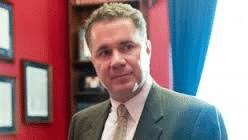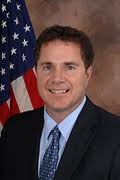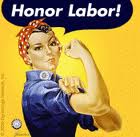
by | May 17, 2013
 Yesterday the Republican-controlled House of Representatives voted once again to repeal Obamacare in full—a vote that passed 229-115 on party-lines besides two democrats who crossed over. Not the least bit surprising was that Rep. Bruce Braley once again voted in favor of Obamacare—but my how much different this must have felt than his first vote for it three years ago.
Yesterday the Republican-controlled House of Representatives voted once again to repeal Obamacare in full—a vote that passed 229-115 on party-lines besides two democrats who crossed over. Not the least bit surprising was that Rep. Bruce Braley once again voted in favor of Obamacare—but my how much different this must have felt than his first vote for it three years ago.
A Different Landscape
Besides the obvious fact that Braley is now a U.S. Senate candidate, a variety of things made yesterday’s vote a much bigger political gamble.
Consider this, on the day the Senate passed Obamacare through the Reconciliation process—March 25th 2010—the Real Clear Politics approval rating for Congress was a shocking 17.4% approve to 77% disapprove. As bad as that seems, at that time in 2010 there was still a residue of “change†excitement in the air, the Tea Party was only just forming, Democrats had not yet lost the House, and President Obama could still credibly make the argument (especially to Independents) that he had successful solutions to the nation’s problem.
Since that day however the absolute failure of the trillion-dollar Stimulus Bill has been fully revealed, the implementation of Obamacare has been continually problematic, the economy has not recovered, and the national debt has further ballooned. And this is not even to mention the numerous scandals and mini-scandals that have surrounded the administration for the past week and a half.
Perhaps even more troubling for Braley’s Senate candidacy is that the mood of the public is remarkably similar to the grim view they had the day Obamacare passed. The following are the RCP polling averages from then and now: Congressional approval on March 25th 2010 was 17.4% approve to 77% disapprove—Congressional approval from 5 days ago on May 9th stood at 16.8% approve to 76% disapprove. Public approval of the Obamacare legislation one day after it passed on March 26th 2010 was 50.7% oppose to 39.4% support–and 8 days ago on May 9th it was 49.8% oppose to only 39% who support.
2014 Impact
For Braley’s purposes what perhaps will be the biggest difference from then and now is he has left the friendly confines of Iowa’s 1st Congressional district (D+ 27,356) and has entered a statewide contest (D+ 4,952). On top of this he has just voted in favor of one of the largest and most expensive initiatives in American history—one which only 39% of the public currently support.Â
Braley no doubt believes in this legislation to his core and will never vote against it. Nevertheless it’s a safe bet that as he pushed the “nay†button yesterday he was keenly aware that the circumstances had changed drastically since his first vote on the legislation. What has transpired since then has not been kind to the bill nor to any purple state legislators voting for it.Â
Though President Obama and many Congressional Democrats were not held accountable for their economic and policy failures in 2012, at some point their luck will run out. If in November 2014 Obamacare still can’t even muster 40% support and implementation keeps getting more and more messy–the Republican who emerges to challenge Braley will need less and less luck.         Â

by | Apr 10, 2013
 Though it will fall short of the intense attention we receive during Presidential years, November 2014 in Iowa will develop into a fierce battleground for both political parties. In spite of the gubernatorial election on the ballot the prize for each side will be the open US Senate seat vacated by Tom Harkin.
Though it will fall short of the intense attention we receive during Presidential years, November 2014 in Iowa will develop into a fierce battleground for both political parties. In spite of the gubernatorial election on the ballot the prize for each side will be the open US Senate seat vacated by Tom Harkin.
While it is a virtual certainty that Bruce Braley will be the Democrat candidate in this race the Republican field is wide open, with no one yet confirming a run. As it stands now Rep. Steve King has been given the “first right of refusal†by fellow potential candidates Kim Reynolds and Bill Northey, and it is widely believed he will have decided by May 1st. One way or another, the field will become clear soon after. In the meantime, here is a first look at the dynamics if the matchup were King vs. Braley.
The Numbers
On last weekend’s Iowa Press Steve King referred to a Republican winning the seat as a “slightly uphill battleâ€â€”and the numbers indeed bear this out. Though they were highly inflated due to it being a Presidential election year, the cumulative votes cast last year in Iowa’s four Congressional districts reveal the Republican will be starting in an electoral hole. In total the four Congressional Democratic candidates (Braley, Loebsack, Boswell, and Vilsack) received 772,387 votes, while the four Republican candidates (Lange, Archer, Latham, and King) received 726,505 votes (D+45,882).
Obviously this is too broad a measure to be definitive but it does give a feel for the obstacles the Republican will face. Far more informative is looking at how Braley and King faired in their individual races. In this scenario the candidate and the electorate in their districts remain the same and the only variable that changes is the opponent. What the numbers show is that Bruce Braley is a better performing candidate than Steve King—something that will likely come as a surprise to many Republicans.
Last cycle Braley went in with a 25,420 voter registration advantage in HD 1 over Ben Lange but won by 59,957—beating the numbers by 34,537. Meanwhile King went in with a 50,396 voter registration advantage in HD 4 over Christie Vilsack but won by only 30,593 votes—losing the numbers by 19,803.
Yes Braley and Vilsack’s numbers were surely inflated due to Obama being on the ballot, and King and Lange were done no favors by Romney’s trouble with Independents, but there is still cause for concern. This is due to the fact that some of this inflated total was surely offset by King facing a far weaker opponent than Braley—Lange was a proven campaigner who came within 4,000 votes of beating Braley in 2010 while Vilsack proved to be an awful candidate who ran a terrible campaign.
These facts are certainly not to suggest a Republican cannot win the seat, they merely offer some context on the difficulties involved and likely explain the caution potential candidates are proceeding with.
Braley vs. King on Paper
The perplexing thing about this potential matchup is that on paper King is a far superior candidate to Braley. While King started an earth moving construction company from scratch, Braley is a trial lawyer and former head of the Iowa Trial Lawyers Association. Though it is true King has a visceral way of approaching issues and a knack for the ill-worded statement, Braley’s voting record reveals he is without a doubt a west-coast Liberal who just happens to reside in Iowa. In fact, besides voting with Democrats and Obama’s agenda 98% of the time in 2008, 99% in 2009, and 98% in 2010, since January 2007 he has voted 91% of the time with Nancy Pelosi. Among these votes of course are Cap & Trade, Dodd-Frank, Obamacare, and authorizing more than $6 trillion in debt over the last four years.
The number one objective for the campaign of whatever Republican takes on Braley will be getting the word out on his voting record. And if the above facts aren’t enough evidence of his poor decision making for Independents in Iowa—you can add he was one of the first to endorse fellow trial lawyer John Edwards for president in 2008.
My Take
In many Republican circles it has become a common belief that Steve King can’t win a statewide race—I do not concur. Perhaps I’d see more truth in this if the candidate on the other side was a moderate instead of one of the most Liberal politicians in the country—funny how we never hear Bruce Braley can’t win a statewide race.
That being said, I am of the belief that our strongest candidate by a longshot would be Kim Reynolds—and we would not risk a House seat in the process. While he would surely have a shot if he ran, undoubtedly the media would exclusively focus on King’s past statements and ignore Braley’s voting record.
In the end I predict that King will decide against running. Whether he proves me wrong or not, whoever takes up this task will have to run hard. Though this is a realistic opportunity for Republicans the numbers show that it indeed will be a “slightly uphill battleâ€.

by | Dec 4, 2012

When the inevitable battle with public-sector employees in Iowa begins to rage here in the next few months and every elected Democrat in the state marches in lock-step with union negotiators, the following will help you understand this phenomenon.
Not only does their ideology lend itself to supporting the concept of an organization/government “protecting” people from the free market–it turns out that this cast of Democrat legislators largely are the unions.
Iowa House Democratic Caucus by Occupation
Below is a look at the occupations of the 46 Democratic members of the Iowa House that will be in office the next two years.
Teachers/Principals former and current = 12
Attorneys = 7
Occupation Unclear = 4
Social Work = 2
1 Each of the Following— Realtor, Farmer, Pharmacist, Grants Coordinator, Funeral Home Business, Golf Course Owner, Banker, Accounting Clerk, Head of Non-Profit Organization, (12 more random single occupations not listed here).
Number who have direct/indirect past or current union backgrounds (mostly public-sector) = 21
Trends
By far the biggest takeaway here is that of the 42 who had a clear current or former occupation that could be found on their legislative page or campaign website, a whopping 21 of them had direct connections to unions–the vast majority of which were public-sector. That is a full 50% of the caucus and does not even include Bruce Hunter, a ranking member of the Labor Committee whose wife is the State Political Director of the AFL-CIO, or Anesa Kajtazovic who goes out of her way to mention in her bio that at a young age her father’s experiences in the workforce led her to be “reminded how important union representation can be.”
The second biggest trend is that 12 of the 42 members with clear employment histories are current or former teachers. This explains why year after year we have a fight in the legislature to increase spending on education by 4% for “allowable growth”–not to mention why firing a teacher is almost unheard of, why there is currently no substantive teacher evaluation, and why there needs to be a Republican push just to ensure that students aren’t passed out of the 3rd grade without being able to read at the proper level, a policy that would seem to be the epitome of common sense. What is not so easily explained is with such a large number of educators doubling as legislators and a majority of the state budget dedicated to it every year, how are the results embarrassingly insufficient in such a large number of districts.
Revealed above is the gross disproportion of representation that unions have in the General Assembly in comparison to the percentage of Iowa’s workforce that they account for. As of 2011 Iowa had nearly 1.4 million people in the workforce. Of this number only 155,000 were in unions (11.2%) and an additional 32,000 were effectively represented by union negotiations while not being listed members, thus bringing the total number of employees directly or indirectly represented by unions to 187,000, or 13.5% of the workforce. Of note here is that the 1.4 million Iowa workers number actually excludes those self-employed so the percentages represented by unions are actually slightly smaller than those listed above. Even taking the larger percentages, while only 13.5% of Iowans are either in or governed by unions, in the Iowa House’s Democratic caucus a full 50% have direct or past connections with unions.
Coming Up
Before the session gavels in I will also do a breakdown of the Republican Caucus by occupation in both Houses (unless one of the Liberal bloggers reading this wants to save me the leg work). It would be very interesting for comparison purposes and may further explain the massive partisan divide we see year after year–my guess is the top 3 for Republicans in some order are small business owners, lawyers, and farmers.
Later this week we will take a look at 3 specific cases that symbolize this dynamic of union/citizen representation in the House, and next week we will have a breakdown of the occupations of the Democrat Caucus in the Iowa Senate. This will be followed by a look at the proposals offered by both the unions and the governor and what is likely to unfold on this front next session.
![Predictions for the Next Four Years (Part 1 of 2)]()
by Steven Waechter | Nov 14, 2012
 Well, Barack Obama will be President for a second term. It is now time to take a look around, and prepare for what is likely to happen next. Based on my observations and what I’ve learned over the years, these are my predictions:
Well, Barack Obama will be President for a second term. It is now time to take a look around, and prepare for what is likely to happen next. Based on my observations and what I’ve learned over the years, these are my predictions:
No Housing Recovery
Commentators have been calling the bottom of the housing market – and screaming with increasing urgency that it was time to buy – since 2007. The Fed has cut interest rates to nearly zero, and through quantitative easing has flooded the financial system with new money. This will continue for the near future, especially since QE-infinity was announced earlier this year. There remains no recovery in the housing market, and there won’t be a recovery.
Bad monetary policy has left the productive bits of the economy in an absolute shambles, and now there simply aren’t enough jobs to allow a recovery in the housing market. This will get worse, not better.
Mass Layoffs
This one will happen sooner rather than later. In an economy that is as sedate as ours the likelihood of reduced unemployment is already pretty slim, and if you consider the looming Obamacare mandates, tax hikes on income, dividends, and capital gains, as well as another four years of an administration that has a penchant for change (breeding uncertainty), I predict that there will be large job losses coming in the very near future.
Growing Poverty
This one seems to fall into place as well, especially for those laid low by the layoffs which I think are coming. But, even those who keep their jobs will experience marked decreases in their standard of living. In an economy where consumption is king and production – or any sort of value-added economic activity – is outsourced, taxed, regulated, or outright banned, the remaining employment opportunities take on a sort of wistful irrelevance. Many will be nominally employed, but at the same time wholly unable to support themselves, let alone able to assemble savings.
Spike in Utility Rates
All forms of energy are likely to get more expensive over the next four years. Obama has explicitly stated that he intends to bankrupt the coal-generated electricity industry in favor of renewable energy kitsch which can only be financially feasible with massive increases in electricity prices. Expect some coal plants to be shut down in the next term, and expect to pay far more for electricity.
High Prices for Oil and Grain
In a past article, I pointed out that since 1990, the United States has run trade deficits in excess of $9 trillion. This despite the fact that in 1990 the supply of dollars (the M2 metric) was only $3 trillion. In an economy where we can buy foreign goods by printing money, there is no reason to manufacture much of anything. This dynamic will continue for the time-being, and we will import shiploads of consumer goods and pay for it with nothing but inflation. This will lead to even higher prices for oil and grain, which are inflation-sensitive commodities whose production cannot be outsourced.
Feeding grain to livestock is a value-added activity, however, and in an inflationary economy the price of grain will go up, and the ability of the public to buy meat will be reduced, so I am predicting a continued decrease in the number of farmers who bother to raise livestock, as well as a decline in the overall size of the livestock herds in the country.
College Tuition Spikes; Enrollment Begins to Fall
Obama’s attempts to reform the student loan industry had nothing to do with controlling the costs of college. The government runs most of the student loan industry, and interest rates have been kept very low for Federal loans. This is all designed to get more kids into college, regardless of what it costs, and with no real limit to the amount of credit available to the college-bound, there are no incentives for colleges to control costs.
The luster has begun to rub off of the whole college experience in my estimation. A college degree has become little more than a very expensive lottery ticket, and new college graduates will not see any discernable increase in their employment opportunities, incomes, or future prospects.
Even with the endless propaganda urging kids to attend college, the decision to attend college will not make financial sense for a large number of American kids, and we will begin to see a decline in enrollments, especially in full-time, traditional enrollments.
((To Continue Reading, Click Here To Go Straight To Part 2))
The post Predictions for the Next Four Years (Part 1 of 2) appeared first on The Conservative Reader.

by | Nov 2, 2012
 Below is the full text of the “Letter to the Editor” I sent to several newspapers in Iowa’s 3rd Congressional District. I believe it makes the case against re-electing Leonard Boswell in a concise fashion. If there is anyone you know still on the fence in this race feel free to forward it to them.
Below is the full text of the “Letter to the Editor” I sent to several newspapers in Iowa’s 3rd Congressional District. I believe it makes the case against re-electing Leonard Boswell in a concise fashion. If there is anyone you know still on the fence in this race feel free to forward it to them.
——————————————————————————————————
For the last ten years I have been represented in the U.S House by Rep. Leonard Boswell. During this time I have often disagreed with his positions, but never have I been more convinced that he has grown out of touch with the challenges facing my fellow Iowans, and our nation at large, than I am this year.
The number one piece of evidence proving this has been his approach to our country’s fiscal matters over the last few years. The reason I am so disappointed in Leonard Boswell is because I did something that has seemingly gone way out of style these days, something even nearly unthinkable actually—I looked up his voting record. More unbelievable perhaps is that I didn’t stop there; I had the nerve to continue doing my civic homework by looking up the record of his opponent Tom Latham as well.
Anyone choosing to do the same will find out that since 2009, the self-proclaimed fiscally conservative “Blue Dog†Democrat Leonard Boswell has cast yes votes on the following pieces of legislation:
• Economic Stimulus Bill—over $800 billion added to the national debt, more than a trillion dollars with interest included (passed the House 246-183 on Feb. 13, 2009).
• Obamacare—price tag of $900 billion over 10 years at passage, most recent CBO scoring nearly doubled this amount to $1.76 trillion (passed the House 219-212 on March 21, 2010).
• Raising the debt ceiling—passed the House 218-214 on December 16, 2009.
• Cap and Trade—according to the Obama administration itself, would have cost Americans up to $200 billion a year (passed the House 219-212 on June 26, 2009).
Meanwhile in the same span he voted against the following measures:
• Cut, Cap, and Balance—passed the House 234-190 on July 19th, 2011
• Debt ceiling bill – This is the John Boehner version that would have raised the debt ceiling in exchange for limits on discretionary spending (passed the House 218-210 on July 29, 2011).
• Reducing spending to F.Y 2008 levels—passed the House 256-165 on July 25, 2011.
Two things of note here are, 1) Tom Latham had the foresight and fiscal decency to vote against all the above bills that Leonard Boswell voted for, and 2) Though Mr. Boswell may have been a fiscally conservative Democrat at some point during his career in Washington—over the last three years he has shown zero concern for the massive debt that has crippled this economic recovery. In fact, he remarkably couldn’t even bring himself to support spending at the level we did just four years ago.
Besides being pleasantly surprised at how rock-solid Tom Latham has been on Federal spending, the thing I took away most from researching these two candidates is how disingenuous it is for Leonard Boswell to claim the mantle of “Blue Dog Democratâ€.
The reason this should matter to voters of all stripes on November 6th is it invites the following question:Â How can we expect our political leaders to do what they say they will once elected, if they are not even who they claim to be while running for office?
Especially since 2009, only one man in this race has had his eyes on the future fiscal health of this country, and by extension the next generation who will inherit this future—and that man is Tom Latham.

 Yesterday the Republican-controlled House of Representatives voted once again to repeal Obamacare in full—a vote that passed 229-115 on party-lines besides two democrats who crossed over. Not the least bit surprising was that Rep. Bruce Braley once again voted in favor of Obamacare—but my how much different this must have felt than his first vote for it three years ago.
Yesterday the Republican-controlled House of Representatives voted once again to repeal Obamacare in full—a vote that passed 229-115 on party-lines besides two democrats who crossed over. Not the least bit surprising was that Rep. Bruce Braley once again voted in favor of Obamacare—but my how much different this must have felt than his first vote for it three years ago.





